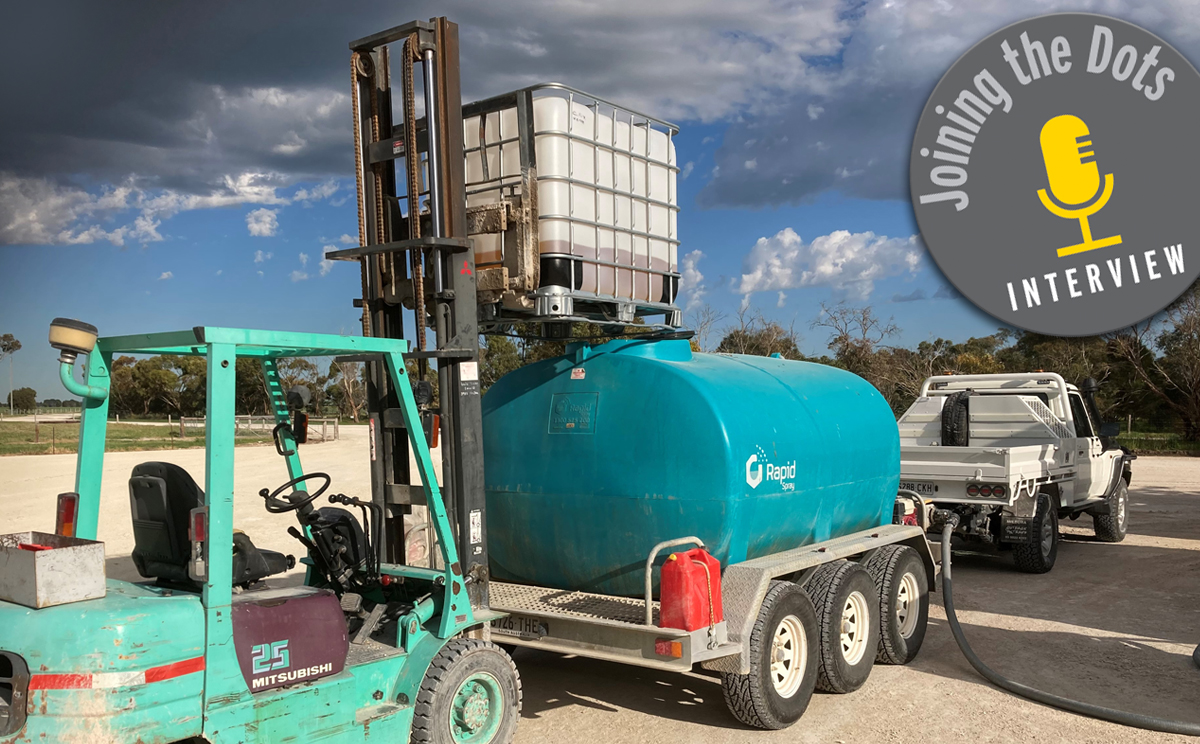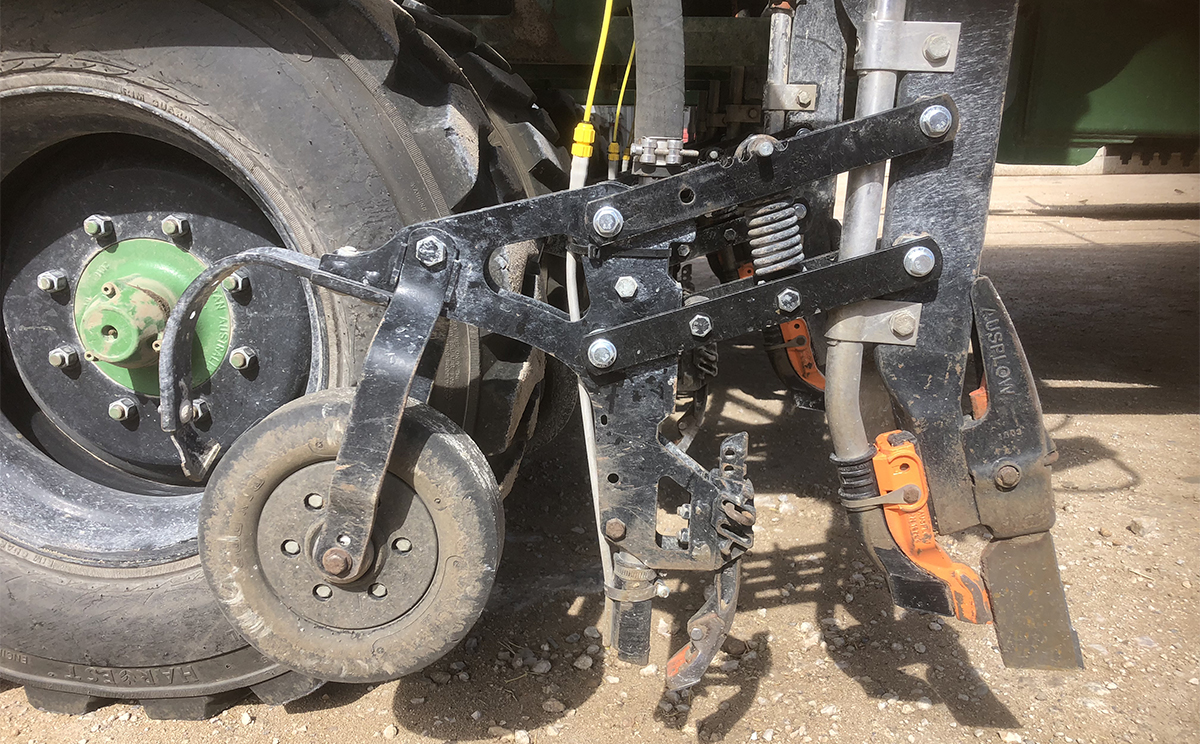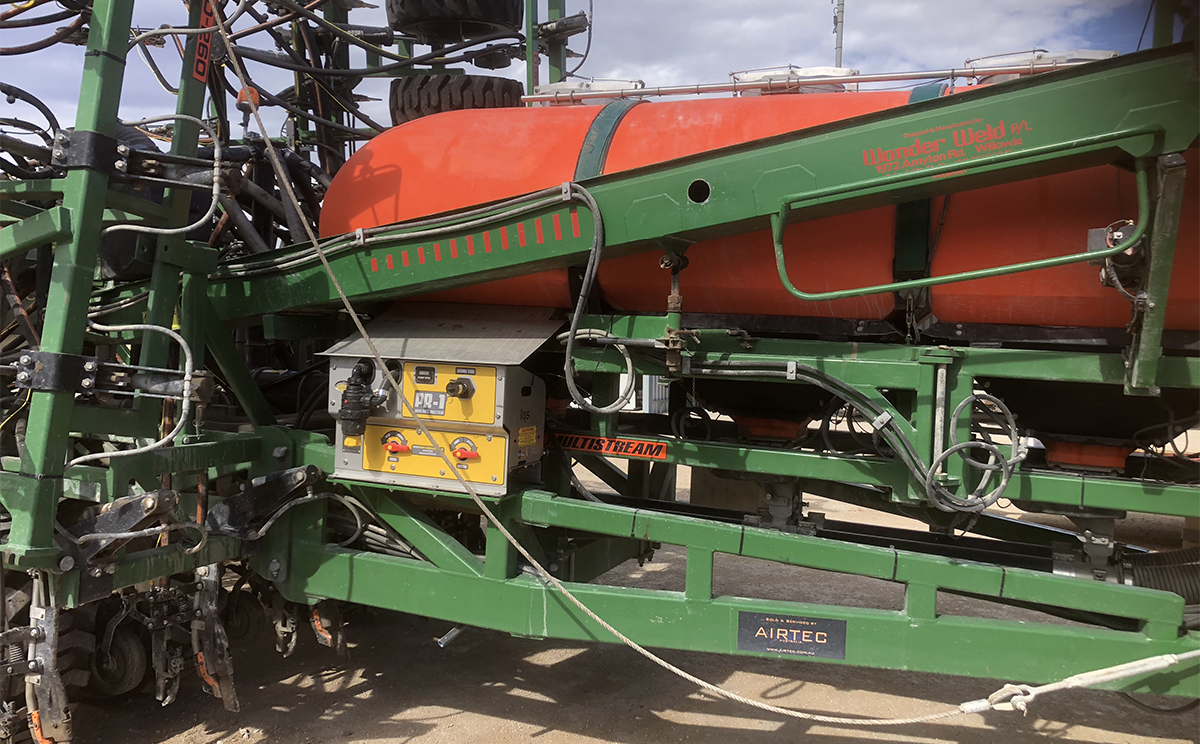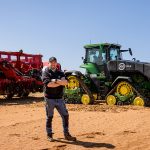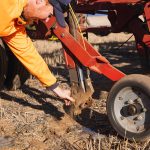Joining the Dots – In-furrow Interview 3
Liquid Systems’ Nicol Morrison interviews Glen Simpson, farmer and farming contractors in the Keith and Tatiara Districts, South Australia.
Joining the Dots about In-furrow application aims to share tips and insights that might not be readily available.
Pictured Above: Glens 6000Lt nurse tank and 1000Lt shuttle fill up method.
How long have you been using liquids for?
How did you approach the planning and handling of the liquids?
Glen
It was a bit daunting first up, but we started off cautiously. You could use an old sprayer, you could use an old firefighter, you could use anything to get started.
Stage one, we started with one seeder with 2000Lt tank mounted on the tractor nose, a 6000Lt nurse tank on a triaxle trailer with a firefighter on the front and we just mix it there on farm. We use 1000Lt shuttles of fertilizer/liquid and we just put them over the top with the forklift and put the right amount in and take that to the paddock and that’s enough for a whole day seeding.
So when we fill up with seed or fertilizer we set that running. Park the nurse truck alongside and then have the liquid going into the tank of the seeder.
Since then, we’re now running two seeders and we’ve set up a four-wheel drive Isuzu truck that’s got a 6000Lt tank on it as well.
Sometimes it works out that on one seeder the tanks a bit bigger. We can do two fields of granules to one a liquid and generally got enough for the whole day at 50Lt /per hectare.
Being a contractor, what is a good tip regarding logistics?
Glen
We like the 1000 Lt shuttles of liquid or wetter or whatever because we can keep it close on our rates. You know exactly how much you’re using. As a contractor to use a bulk tank is harder to keep track. Especially when we’re going to other people’s farms and they want us to supply the liquid, we can’t be 100Lt out. We must be able to charge out the correct amount.
When we go out to a big job, I normally get the client to have the liquid on site in their shuttles and we just take our triaxle trailer. They supply the water and we pop the liquid in. So it’s a mixed up mix. By using the shuttles and a forklift it saved spending money on base tanks and extra pumps and stuff.
How often do you order product?
Glen
Once a year. I go off last year’s use and a little bit less than that. We then top up at the end of season if required, we get locally here from Nutrien.
We start with a semi load of 1000Lt shuttles and we just return the shuttles afterwards.
Anything challenging regarding the design of the nurse tanks?
Glen
To try and make it legal! The nurse tank is a triaxle and when full, It’s six tonne on six wheels, so towing it with a Land Cruiser Ute it’s not great. When we have to go along way, we work around, put the neat product in and when we get there, fill it up with water so you’re not carting six tonne around. And if we’re at the shed here filling up, ready to go out the paddock, we load up here. And then reload the truck or the nurse tank so that you’ve already got one load in front. Generally, we don’t have two people around when we’re loading. If someone’s around, they help. But if not, the boys have that ticking away as you’re filling up with granules and grain.
How many labour units do you usually have?
Glen
Now we run two seeders. I’ve got one, plus myself, I’m the bloke in the middle that runs the trucks with the granules and the seed and then drops the nurse tank out there, just unload off the ute and leave it on site. I try and time it so that when I get there, I help them fill up. But really, it’s only a little bit of preorganization and just having it premixed. In the morning, get up a whisker earlier, have that preloaded.
How many acres of land are you covering nowadays?
Glen
About 25,000 acres. Not all of that has liquid, mind you. Probably half to two thirds is liquid. I don’t know why some people don’t do it. I don’t charge anymore for it as long as they’re organized and have got the stuff there.
What liquids are you applying in furrow?
Glen
There’s a lot of jobs we’ve got because we run the wetting agent through it and that got us a lot of work in the lighter country. We haven’t been seed treating. We still got that on our seed.
We have a canola blend, a cereal blend, and then just straight zinc on beans.
Hypothetically, if we were on zinc, on beans and there’s 100Lt left in the tank, we don’t dump it out. We just put the cereal mix in on top, which is a manganese, zinc, copper, they’re all compatible, so we never have to wash out. We flush fresh water through the system if we’re going to pull up for a while.
To minimise wasting time, make sure everything’s compatible. If you don’t, you could waste a lot of time, for example going from canola to beans. And so we just put the mix straight in on top so it doesn’t matter.
And the reason we’ve done that, is to keep it very simple, because if we have numerous different blends, when you’re under the pressure of seeding, we run 24 hours a day. It would be just too hard.
But if a customer wants a special blend, if he’s got it there, we put it through. So it’s not an issue, it can be done. We just try not to make it too complex.
Nicol: Down your way with the non-wetting soils, wetter would be critical.
Glen: Yeah, Marvellous
Nicol: Have clients given you feedback?
Glen: Yeah, very positive. Had very good strike. And we’ve been playing around with different rates of wetter and different brands as well. And I think for Lucerne establishment on light non wetting soils, it’s just a must and we can’t rave about it enough.
Nicol: With the cereal crops, that will be a UAN and trace element mix?
Glen: Yeah. Not a huge amount of UAN, but more on trace elements side. Beans is zinc, the canola mix is a bit of boron and I just tweaked a little bit to suit, but haven’t gone right out of the square.
Nicol: Is the inoculant for the beans on the seed itself?
Glen: Yes. Or we use a granular inoculant. We haven’t gone down the tube with that yet.
Nicol: Probably in the future?
Glen: Yeah
Nicol: It will have to be a separate batch. Because the research is showing that you shouldn’t put the inoculant in with anything else. Basically.
Glen: Yes. That’s right.
So regarding liquid placement, what did you decide?
Glen
We’ve got it on the DBS, so we’ve got it just behind the closing tool in front of the press wheel. So basically, it’s with the seed, 10mm under the ground. Not on top afterwards. So it’s not with the fertilizer down the bottom with the seed. We did that for the wetting agents, mainly because you can’t put the wetting agent down the fertilizer one, ends up too deep and we can’t go on top of the row behind the press wheel as it will get knocked off on stumps and stones and hit the bar when the tine breaks out.
Get a Quote
"*" indicates required fields

